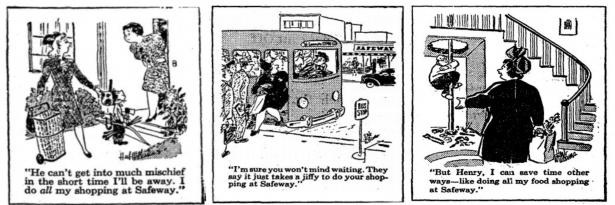Recently, I found myself drawn back to the Colorado Historic Newspapers site, curious to discover what kinds of headlines were on display following America’s use of the atomic bomb. As it turns out, there was surprisingly little discussion about this monumental event, perhaps because the smaller papers favored on the site tended to focus most of their attention on local events.
That’s not to say I found nothing which piqued my curiosity - merely that it had nothing to do with the bombings of Hiroshima or Nagasaki. Rather, it was an ad for the Safeway grocery chain which caught my eye. After getting over my initial shock on seeing coffee advertised for 26¢ a pound, I noticed the comic strip at the bottom of the announcement.
The heading “What every young bride should know” certainly got my attention, but it was the final line “Won’t Jim be proud!” which cemented my interest. This single, archaic phrase spoke volumes about the era in which it was penned. Thus began my fruitful odyssey delving voraciously into back issues of the Steamboat Pilot.
Above is the earliest example of this style of their advertising I could find, taken from the June 4, 1942 issue. It’s clear that the themes and gender roles were already established, as was the common trope of the knowledgeable friend who saves the day (and perhaps the marriage) by revealing the “secret” of Safeway. This was the standard plot (and I use that word in the loosest possible sense) of most of the strips, but occasionally they veered into… stranger territory.
Perhaps I’m being naïve, but I find it a bit hard to believe that retail has changed that much over the years. As someone who’s spent a significant amount of time in customer-service fields, it’s been my experience that “snarling” and “growling” at clients rarely results in repeat customers. Then again, perhaps that was the point they were striving for.
At times, they would abandon the Mary Worth style strip in favor of a single-panel cartoon. These strove for a more humorous tone, with decidedly mixed results. Rather than focusing on the high quality of their meats, or the thriftiness of buying produce by the pound, they tended to emphasize how much time could be saved by shopping at Safeway.
The campaign was apparently successful, and perhaps not surprisingly lead a competitor, The Boys Market, to create copycat content. There’s something disconcerting about this particular ad which brings to my mind Quint’s speech from Jaws regarding “…lifeless eyes, black eyes, like a doll’s eyes.” The art style tended to be less refined, but the wives were still sufficiently Stepford in their nature.
With the holidays upon us, budgetary concerns are on a lot of our minds. Whether your own ambitions are limited to a new vacuum cleaner, or you have loftier goals (like perhaps a microwave oven), it’s nice to know that a fine business like Safeway has our backs.*
*Neither the Denver Public Library nor this author endorses Safeway, or indeed any other retail establishment.
If you find content like this entertaining or edifying, you may be a bit odd… but that’s okay. We like odd. Pay Western History and Genealogy a visit on the 5th floor of the Central library, where you can peruse a vast collection of old newspapers on microfilm. Also, be sure to like our Facebook page so you don’t miss out on any of our updates.


Comments
what date was the full page
what date was the full page ad published? Based on the header info re national brands week, would look like 1941 based on sunday-saturday week dates. but narrative says earliest example you noted (for comics) was 1942.
NOTED interestingly, no pork, chicken, or fish listed. fall vegetable selection fits with October. Thanks!
Hi Paul! Thanks for the
Hi Paul! Thanks for the interest!
The full ad displayed at the top was pulled from the October 4. 1945 issue.
Without doubt, beef, veal and lamb were the most frequently advertised meats. There were occasional offerings of "fryers" and possibly some "pork sausage" but those were few and far between (and I don't believe I ever saw fish advertised outside of canned tuna).
Once in a while, rather than any specials, they had a disclaimer stating that, though they'd certainly have meat available, they couldn't make any promises about what would be available, nor how much they would have in stock.
Funny read!
Funny read!
Glad you enjoyed it!
Glad you enjoyed it!
The Boys Market strip you
The Boys Market strip you cite as created to compete with the Safeway material was actually part of a package of strips that markets all over could license and put their name in... and far from being created in reaction to the Safeway strips, they actually predate them; I've found the specific strip you show used back in 1938. (I'm a small publisher working on a book collecting the Safeway strips, so I've been going down the rabbit hole on this topic.)
I appreciate you letting me
I appreciate you letting me know! I'll see what we can do to get this updated with the new information. Thanks, Nat!
Add new comment